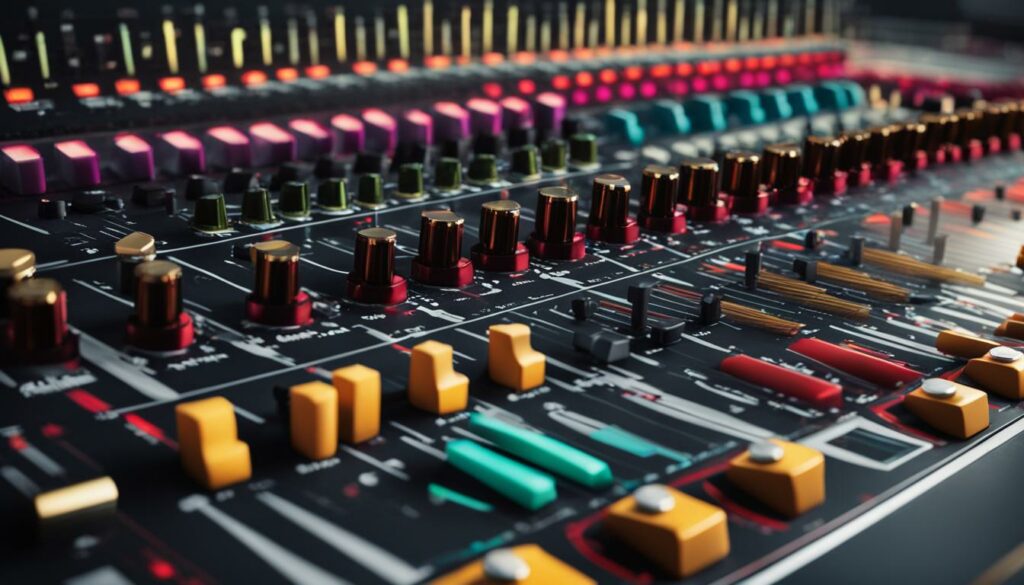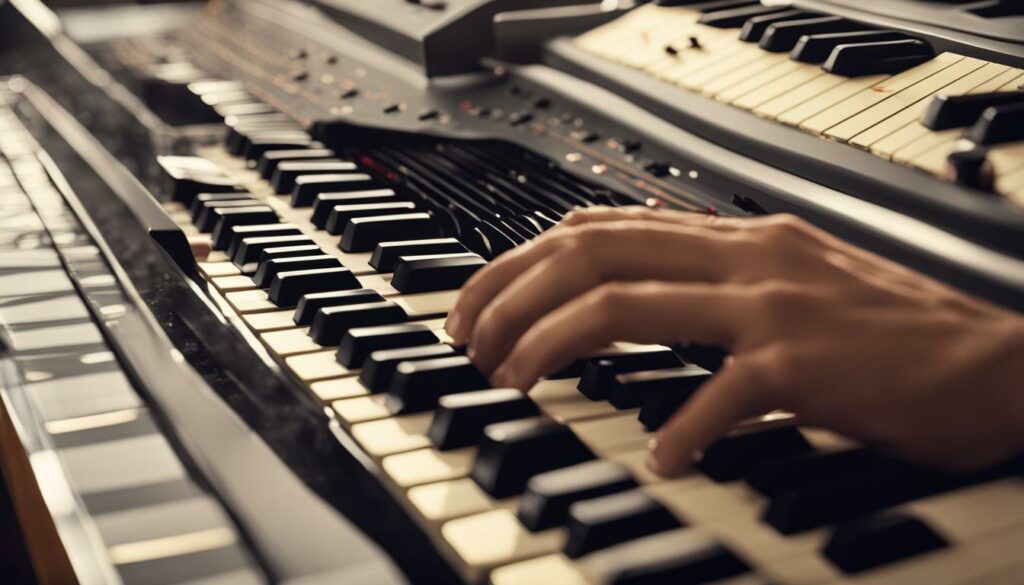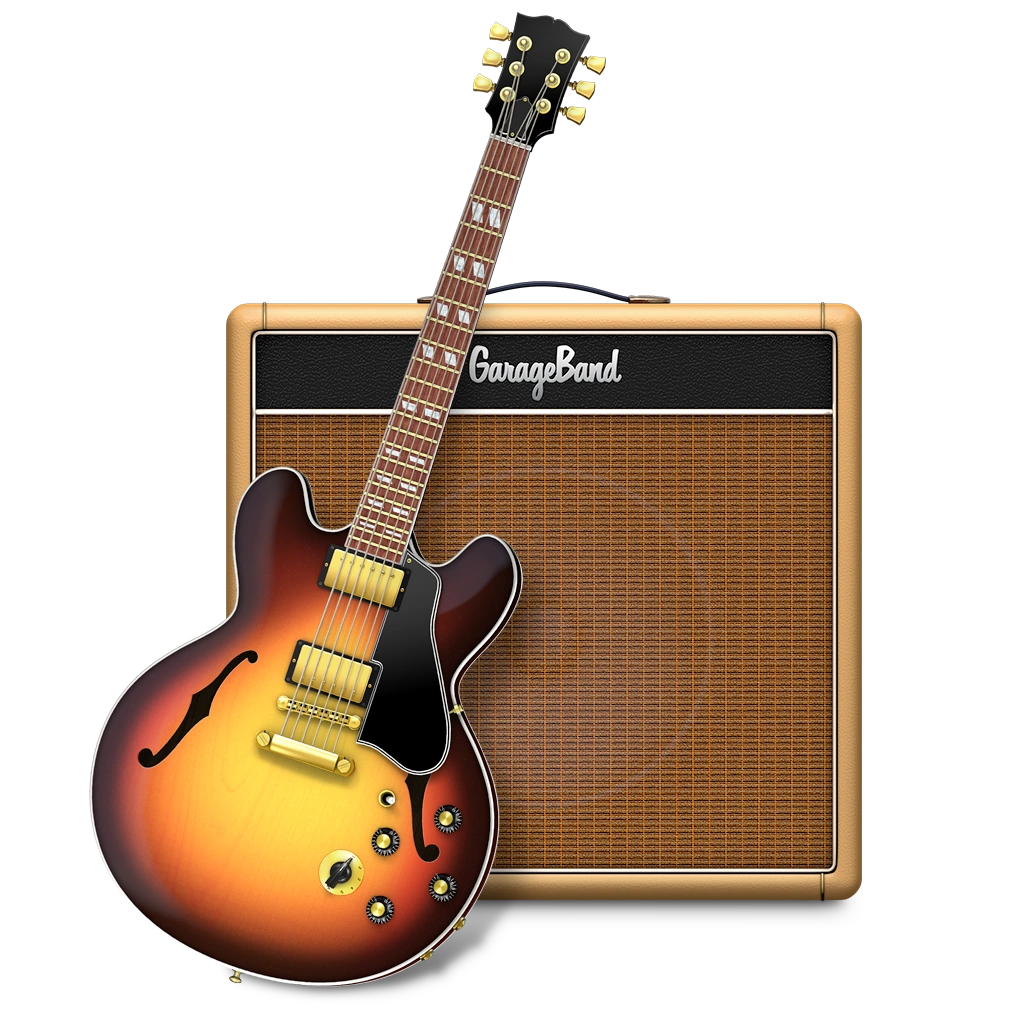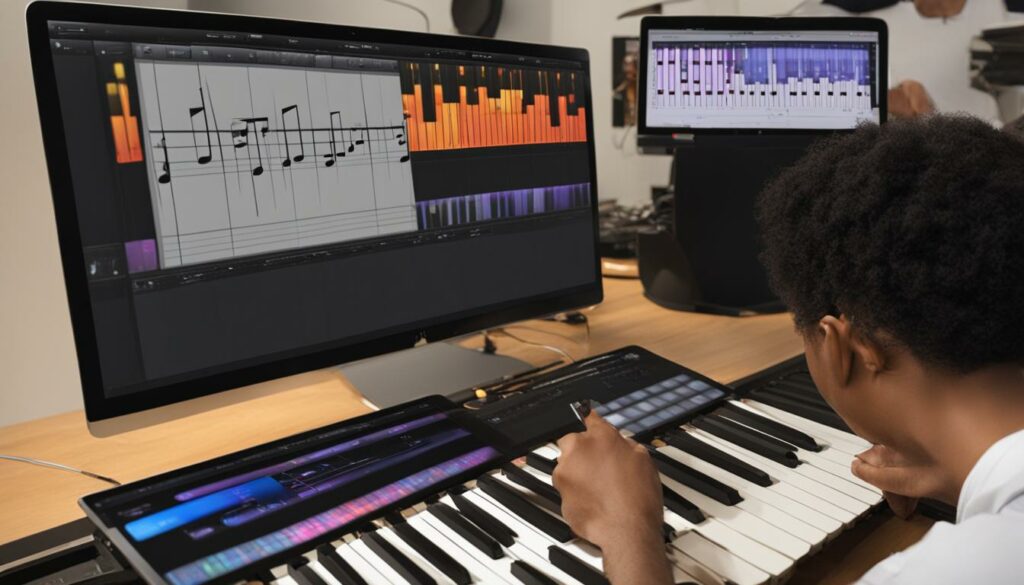As we delve into the world of music production, the pursuit of rhythmic perfection often leads us toward innovative tools and techniques. Among the arsenal of options available to producers and musicians, the ability to quantize in GarageBand stands out as a game-changer. This powerful feature facilitates precise timing correction across various types of audio track editing, ensuring that every note and beat aligns flawlessly with our project’s tempo.
Through the intuitive interface of GarageBand, we are equipped to finetune the timing of regions within an audio track—a resource especially valuable when the recorded elements contain the correct notes but lack synchronization with the desired beat. By making nuanced adjustments to the selected regions on the track, and choosing the right note value for timing quantization, our music not only sounds professional but also resonates with the precise timing that listeners expect.
Understanding Quantization in Music Editing
Exploring the realm of music editing, we recognize that the heart of achieving professional-sounding audio lies in its timing. The process of GarageBand quantization provides us with an indispensable tool for ensuring that our recordings resonate with the intended precision and unity. This technique allows us to align notes within audio and MIDI regions, adhering closely to the project’s tempo without sacrificing the originally captured nuances.
When we apply quantization in GarageBand, the focus extends beyond mere alignment. We value the essence of a performance, seeking to correct those slight deviations in timing that, if left unaddressed, could disrupt the flow of the track. To engage in this form of audio synchronization, we select the regions in need of adjustment, making certain that our creative intent remains untouched while enhancing the listener’s experience with impeccable timing.
The non-destructive nature of quantization in GarageBand provides us with the freedom to experiment. We adjust the strength of the quantization effect, making our process much like a sculptor’s; chiseling away the excess, we reveal the envisioned rhythm beneath. Whether the changes are subtle or significant, the control remains ours, allowing us to fine-tune our music to the exact degree required.
Audio synchronization in GarageBand presents a beautiful balance between automation and artistry. It encompasses more than the click of a button—it involves a deep understanding of rhythm, the structure of music, and the capabilities of the tools at our disposal. As we continually navigate the landscape of music editing, the power of quantization stands as one of our most reliable guides.
Step-by-Step Guide to Quantizing Audio Tracks in GarageBand

When we embark on the journey to refine the rhythm of our music, audio track quantization in GarageBand can dramatically streamline the process. Now, let us guide you through the step by step process to quantize in GarageBand, ensuring your tracks display the rhythmic precision that resonates with your artistic vision. It’s a straightforward yet powerful method for timing adjustment that brings professionalism and polish to your audio projects.
First, we commence by selecting the audio regions that we aim to quantize. These regions should ideally lie on the same track to maintain consistency in the quantization process. Next, we focus on the Audio Editor inspector, making sure the Region button is activated to inform GarageBand of our intent to adjust the entire region.
After successfully selecting our targeted regions, we turn our attention to the Time Quantize pop-up menu. In this pivotal step, we’re presented with a variety of note values—each representing a different rhythmic division, allowing us to choose the one that best aligns with our track’s tempo. This is where we sculpt the timing of our music, ensuring that each note contributes to the seamless groove we’re striving to achieve.
Finally, our journey towards achieving a quantized masterpiece leads us to the Strength slider. Dragging this intuitive control allows us to determine the intensity of quantization applied to our regions. A gentle slide to the left means a softer touch, retaining more of the human element, whereas a firm push to the right tightens up the timing, aligning our notes with robotic precision.
Throughout this quantization process, we maintain a balance between technological precision and the expressive quality of human performance. GarageBand’s tools empower us to bring out the best in our tracks without losing the essence that makes music truly captivating.
Perfecting MIDI Timing: Quantizing MIDI in GarageBand
In our quest to produce music with impeccable rhythm, quantizing MIDI in GarageBand stands as an essential element for MIDI editing. Whether we’re working on a complex symphony or laying down a simple beat, the granular control offered by the Score Editor ensures our MIDI notes hit right on the mark, every time.
The Essentials of GarageBand’s Score Editor for MIDI Quantization
GarageBand’s Score Editor is our go-to destination for MIDI quantization controls. It deftly allows us to handle entire MIDI regions or finesse individual notes to perfection. Within this editor, not only are we empowered to correct timing issues, but we can also visually quantize notes, preserving their legibility while engaging in precision editing.
Adjusting MIDI Note Timing with Precision
As we immerse ourselves in adjusting MIDI note timing, the Score Editor’s detailed framework aids us in selecting specific notes that require timing corrections. Manipulating the Time Quantize pop-up menu, we then assign a note value that mirrors the tempo we intend to convey. Subsequently, with a delicate touch or a firm hand, we adjust the quantization strength using the intuitive Strength slider, tailoring the timing to the exact needs of our musical endeavor.
Our collective journey through MIDI sequencing is never at the mercy of imprecision, thanks to these robust quantizing MIDI in GarageBand functionalities. This blend of intuitive design and powerful editing capability ensures that our melodies carry the rhythmical accuracy and expressive timing that define professional-quality music production.
Utilizing Smart Controls for GarageBand Beat Quantization
In the realm of digital music production, precision holds the key to a polished final piece. Our proficiency with GarageBand beat quantization is indicative of our meticulous approach to music editing. We understand that timing can make or break a track, and that’s where the Smart Controls come into play. Charged with impactful features, these controls are the hub where we finetune our music for that crisp sound.
Smart Controls in GarageBand, equipped with the Quantizer function, serve as our companion in the journey to refine beats. With this resourceful feature, we make beat adjustments effortlessly, ensuring our rhythmic elements fall in place perfectly. As we select a track and hit ‘B’ on the keyboard, we unveil the comprehensive quantization options that lay the groundwork for impeccable timing corrections.
The transformative aspects of Smart Controls include the selection of note values which lay the foundation for quantization. This allows us to designate exactly how we’d like our beat to be adjusted. From intricate triplets to straightforward quarter notes, our selections reconcile the music’s rhythm with the intended tempo. Moreover, the Strength slider provides us with nuanced control over how strongly the quantization is applied, tailoring beat precision with a discerning touch.
Ultimately, what sets apart a seasoned producer from the rest is the deft use of such tools. As we manipulate the offerings of Smart Controls in GarageBand, we are not just aligning notes mechanically, we are sculpting the rhythm to breathe life into our music, syncing every beat to the vibrant pulse of creativity. The finesse with which we employ beat quantization is a testament to our commitment to excellence in music production.
The GarageBand Quantize Function: A Tutorial
Our collective mission to refine and perfect the rhythm of our tracks finds an ally in the GarageBand quantize tutorial. Here, we’ll embark on discovering how to access and utilize the Quantize Function, a powerful staple in GarageBand’s editing suite. It’s not just about aligning beats; it’s also about preserving the groove that gives music its character. So, let’s pull back the curtain and explore this essential feature.
Exploring GarageBand’s Smart Controls for Quantization
As we start exploring Smart Controls in GarageBand, we find ourselves at the core of where quantization magic happens. Nestled at the bottom of the interface, Smart Controls present us with a panel of options tailored for precision editing. Here, in this musical command center, you’ll find the key to aligning your music perfectly with the rhythm grid.
Embarking on the quantization function guide, we venture into setting the desired note and quantization strength. The process can dramatically shift a note or subtly nudge it to fall in line with the grid. It allows our music to maintain its natural flow while also adapting to the strict timing that a polished track demands.
Whether you’re striving for a rigidly timed techno beat or a slightly laid-back jazz groove, understanding and using GarageBand’s Quantize Function is instrumental. Follow these insights, and your productions will not just sound on time—they’ll feel right.
Quantizing Real Instruments Recordings in GarageBand

When we record music with real instruments, the raw energy and human touch come with inherent slight timing differences. It’s what makes the music breathe, but sometimes, it can lead to a slight disarray when we aspire to the polished sound that’s often the industry standard. Here is where the beauty of quantizing real instrument recordings comes into play. The nuanced process not only ensures that each note strikes at the ideal moment but also preserves the inherent soul of the performance.
From Slight Adjustments to Perfect Harmony
GarageBand’s robust quantization tools are as adaptable to live recordings as they are to MIDI. With features like the Flex tool and Smart Controls Quantizer, even the most delicate notes that stray from the planned tempo can be effortlessly nudisaplligned back into proper timing. These audio adjustments are subtle yet potent, never overtaking the track’s natural dynamics but complementing them to create a seamless blend of the musician’s intent and rhythmic accuracy.
To employ these quantization features effectively in our projects, we first ensure that the raw audio files – commonly displayed in orange – are set to ‘Follow Tempo & Pitch.’ This option is pivotal as it allows the software to make tempo-based adjustments to these recordings. Next, we carefully select the regions of audio we aim to enhance and, through the Audio Editor inspector, our focus shifts to the selection of the optimal note value for our quantization needs.
The strategic positioning of each note, aided by quantization, significantly contributes to achieving harmony in a track. It’s akin to fine-tuning an instrument before a performance, where every adjustment, no matter how minor, can have a profound impact on the overall sound. With GarageBand, we have the capability to make these adjustments retrospectively, ensuring every strum, hit, or blow aligns in perfect synchrony with our envisioned tempo.
Dragging the Strength slider to the appropriate level adds the final layer of polish to our quantization efforts. A lower strength setting will maintain more of the original timing and feel, while a higher setting tightens the timing to a near machine-like precision. We believe in the importance of this nuanced control, as it helps us balance the human element with the demands of contemporary music production standards.
Ultimately, through the smart application of GarageBand’s quantization features, those once slightly misaligned notes now contribute to a well-orchestrated ensemble, where every element plays its part in achieving harmony. It is indeed a fusion of art and science, one that enhances without overpowering, and celebrates precision without stifling expression.
GarageBand Quantization Strength: Finding the Balance
In our pursuit of musical excellence, we understand that the essence of a track often lies in its rhythm. With GarageBand’s quantization features, we possess the prowess to sharpen our music’s timing to near perfection. However, the true artistry lies within balancing quantization—it’s about maintaining the human touch while achieving technical accuracy. The key to this equilibrium is in understanding and manipulating the GarageBand quantization strength to cater to our track’s individual needs.
Customizing Quantization for Your Tracks
Every piece of music tells a different story, and with track customization, we ensure that narrative isn’t lost in a mechanical translation. The quantization strength slider in GarageBand acts as a fine tuning tool, bestowing upon us the capability to align our notes with finesse. A light slide to the left, and we allow greater human expression through subtle timing deviations; a firm push to the right, and we embrace the crisp synchrony of a tight rhythm section.
Using the strength slider isn’t just a process—it’s a decision that affects the sonic character of our project. When we initiate GarageBand track customization, we’re not simply choosing settings arbitrarily; we’re making informed choices to preserve the dynamism and flow unique to our creation. This tool isn’t just about correcting; it’s about enhancing, breathing life into our work with just the right touch of precision. Thus, we walk the line between the mechanically precise and the organically expressive, orchestrating harmony between human feel and mathematical timing.
Quantizing With GarageBand on Windows: Click and Play
For those who have longed for the seamless functionality of GarageBand on Windows, the search is over. We now have the ability to harness the full power of GarageBand’s quantization features on Windows PCs. This marks a monumental shift for music producers and hobbyists alike, providing the same level of precision and ease of use that Mac users have enjoyed for years.
The official GarageBand download for Windows is a milestone for music production, bringing with it the effortless ‘click and play’ experience that has been the hallmark of the macOS version. We are no longer restrained by the limitations of emulators which often introduced unwanted complexity and performance issues. This native application ensures that producers can dive into quantization and audio editing with the confidence of stable, reliable performance.
Our musical creativity should not be hindered by the tools we use or the platforms we operate on. The transition to using GarageBand on Windows represents a broader push towards inclusivity in the music production sphere—making it possible for anyone with a Windows PC to create, edit, and perfect music without emulators standing in the way.
Dedicated to providing an authentic, rich user experience, the official GarageBand download has finally bridged the gap between Mac and Windows users. Now, every aspiring artist and seasoned producer can enjoy the same, unfiltered access to one of the most powerful music editing software packages available, and focus on what truly matters—the music.
Everything from recording live instruments to programming complex MIDI sequences benefits from the robust quantize function now available on the Windows platform. With a simple ‘click and play’ approach, our music is quantized with remarkable accuracy and speed. This leap forward not only democratizes music production but also expands the horizons of creativity and innovation for all who venture into the world of digital audio workstations.
Navigating Common Quantization Challenges and Tips
In the pursuit of rhythmic accuracy within audio editing, it’s paramount to address common quantization challenges that can arise. One such challenge is the risk of over-quantization, which has the potential to strip the music of its intrinsic “soul.” It’s a delicate act—achieving the mathematical precision of quantization while preserving the natural human feel that gives music its depth and warmth. Our editorial provides essential quantization tips to help maintain this equilibrium and leverage the benefits of quantization effectively.
Understanding the nuances of different musical genres is a foundational step we take. It informs our choices when engaging with the Quantizer in GarageBand, enabling us to select the appropriate note value settings that complement the genre’s characteristic tempo and rhythm. Additionally, we must not underestimate the power of thoughtful manual adjustments, where we fine-tune the alignment of notes, accommodating for the natural variations that live performances entail. Delving into audio editing guidance, our aim is to wield quantization as a tool that not only corrects but also enhances, without sterilizing the essence of the track.
It’s our collective expertise that allows us to navigate the intricacies of quantization, ensuring our tracks are both technically correct and evocative. With discernment and a keen ear, we evoke the intended emotional response in listeners. By applying these strategies and considering the context in which they are used, we elevate our music editing endeavors to outcomes that resonate with both accurate timing and authentic musicality.
FAQ
How do I quantize an audio track in GarageBand?
To quantize an audio track in GarageBand, select the track you want to adjust, open the Audio Editor inspector, choose a note value from the Time Quantize menu, and use the Strength slider to modify the quantization intensity until you achieve the desired timing correction for your track.
What is quantization in music editing?
Quantization in music editing is the process of aligning the timing of notes to a predetermined musical grid, which can help correct timing discrepancies between notes and ensure they are in sync with the project tempo. It is a fundamental technique for achieving precise timing in audio tracks within GarageBand and other music production software.
Can you quantize MIDI in GarageBand as well as audio?
Yes, you can quantize both MIDI and audio in GarageBand. For MIDI, the quantization process can be done in the Score Editor where you can choose to quantize entire regions or individual notes, adjusting them to the correct timing with the quantization note value and strength controls.
How do I use Smart Controls for beat quantization in GarageBand?
To use Smart Controls for beat quantization in GarageBand, select the track you want to adjust, press ‘B’ to open the Smart Controls at the bottom of the interface, then pick the desired note value for quantization, and use the Strength slider to fine-tune the beats to match the intended rhythm of your project.
What are the steps for quantizing a MIDI track using GarageBand’s Score Editor?
To quantize a MIDI track using GarageBand’s Score Editor, open the MIDI region in the Score Editor, select the notes or entire region that you wish to quantize, choose the appropriate note quantization value, and adjust the Strength to the desired level to align the timing of the notes with the grid.
Can you make slight adjustments to real instrument recordings with GarageBand’s quantization?
Yes, you can make slight adjustments to real instrument recordings in GarageBand by enabling the Flex feature and using the Smart Controls Quantizer. You can then align slightly misaligned notes with the rhythm grid to achieve a cohesive sound in your track.
What is the significance of GarageBand’s quantization strength feature?
The quantization strength feature in GarageBand allows you to control the intensity of the quantization effect. This means you can determine how significantly the program should correct the timing of notes. A low Strength setting nudges notes closer to the grid for a more natural feel, while a high setting forces strict alignment for a tight robotic sound.
Is GarageBand available for Windows users?
Yes, GarageBand is now available for Windows users. You can access the official GarageBand for Windows PC through a free and safe download from the resource homepage, enabling a straightforward click-and-play experience without needing any emulators.
How do you avoid over-quantization and retain a track’s musical feel?
To avoid over-quantization and retain a track’s musical feel, use quantization thoughtfully. Understand the genre’s nuances, choose the right note value for each part, and make manual adjustments when required to maintain natural timing variations of live performances. It is about balancing between technical precision and the human element in music.


